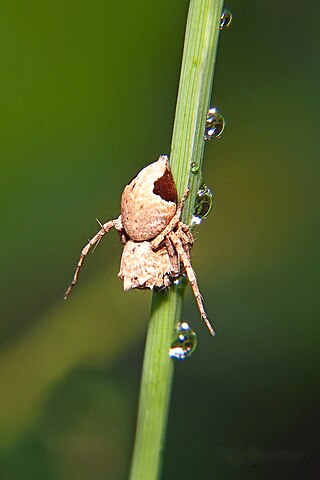
The Pholcidae are a family of araneomorph spiders. The family contains more than 1,800 individual species of pholcids, including those commonly known as cellar spider, daddy long-legs spider, carpenter spider, daddy long-legger, vibrating spider, gyrating spider, long daddy, and skull spider. The family, first described by Carl Ludwig Koch in 1850, is divided into 94 genera.

Corinnidae is a family of araneomorph spiders, sometimes called corinnid sac spiders. The family, like other "clubionoid" families, has a confusing taxonomic history. Once it was a part of the large catch-all taxon Clubionidae, now very much smaller. The original members of the family are apparently similar only in that they have eight eyes arranged in two rows, conical anterior spinnerets that touch and are generally wandering predators that build silken retreats, or sacs, usually on plant terminals, between leaves, under bark or under rocks.

Dysdera is a genus of woodlouse hunting spiders that was first described by Pierre André Latreille in 1804. They originated from Central Asia to Central Europe.

Crossopriza is a genus of cellar spiders that was first described by Eugène Louis Simon in 1893.
Litoporus is a genus of cellar spiders that was first described by Eugène Louis Simon in 1893.

Panjange is a genus of leaf-dwelling spiders in the family Pholcidae, widely distributed in the islands of Southeast Asia from Borneo and the Philippines to northern Australia. Panjange spiders exhibit some of the most extraordinary morphology among Pholcidae. Males of most species have eye stalks, sometimes with long pointed processes; males of some species have unusually elongated pedipalps, which in spiders function as copulatory organs; and females of some species have external portions of their genitalia strongly folded and extensible. The biological significance of these sexual modifications remain unclear.
Utivarachna is a genus of Asian araneomorph spiders in the family Trachelidae first described by Kyukichi Kishida in 1940. It was largely ignored until Christa L. Deeleman-Reinhold revised the sac and ground spiders in 2001, transferring some species from Trachelas and adding several new ones. The genus was further expanded in 2014 and 2015.

Artema is a genus of cellar spiders that was first described by Charles Athanase Walckenaer in 1837.

Ochyrocera is a genus of midget ground weavers that was first described by Eugène Louis Simon in 1892.

Xyphinus is a genus of goblin spiders that was first described by Eugène Louis Simon in 1893.

Hamataliwa is a genus of lynx spiders that was first described by Eugen von Keyserling in 1887.

Christa Laetitia Deeleman-Reinhold is a Dutch arachnologist. She specializes in spiders from Southeast Asia and Southern Europe, particularly cave-dwelling and tropical spiders. She donated a collection of about 25,000 Southeast Asian spiders, the largest collection of Southeast Asian spiders in existence, to the Naturalis Biodiversity Center in Leiden. In addition to numerous articles, she has written the book Forest Spiders of South East Asia (2001).
Tissahamia is a genus of southeast Asian cellar spiders named after Wanniyalaeto chief Uru Warige Tissahami. It was erected in 20180 for several species transferred from Pholcus after a molecular phylogenetic study of the Calapnita-Panjange clade of Pholcidae. They have long, thin abdomens that bend upward near the end. They also have six eyes, three on each of two eye stalks.
Apokayana is a genus of southeast Asian cellar spiders named after the Apo Kayan people of Indonesia and Malaysia. It was erected in 2018 for ten species transferred from Panjange after a molecular phylogenetic study of Pholcidae.
Arenita is a monotypic genus of South American cellar spiders containing the single species, Arenita fazendinha. It was first described by B. A. Huber and L. S. Carvalho in 2019, and it has only been found in Brazil.
Kairona is a monotypic genus of South American cellar spiders containing the single species, Kairona selva. It was first described by B. A. Huber and L. S. Carvalho in 2019, and it has only been found in Brazil.
Nipisa is a genus of southeast Asian cellar spiders erected in 2018 after a molecular phylogenetic study of Pholcidae. It consists of ten Calapnita species, previously the phyllicola group of Pholcidae, now elevated to genus rank. They are pale whitish in color, with a cylindrical abdomen and relatively long legs. The name is derived from the Malay "nipis", meaning "thin", in reference to the long, thin abdomen.
Saciperere is a monotypic genus of South American cellar spiders containing the single species, Saciperere catuaba. It was first described by B. A. Huber and L. S. Carvalho in 2019, and it has only been found in Brazil.
Pinoquio is a monotypic genus of South American cellar spiders containing the single species, Pinoquio barauna. It was first described with the name Pinocchio by B. A. Huber & L. S. Carvalho in 2019, after Pinocchio, whose famous nose reminded the authors of the projecting clypeus in P. barauna. However, this name turned out to be a junior homonym that had been used before, for the harvestman genus PinocchioMello-Leitão, 1940. Therefore, the genus name was amended in 2022 to Pinoquio, which is the Portuguese spelling of the name of Collodi's famous character. This genus has only been found in Brazil.









